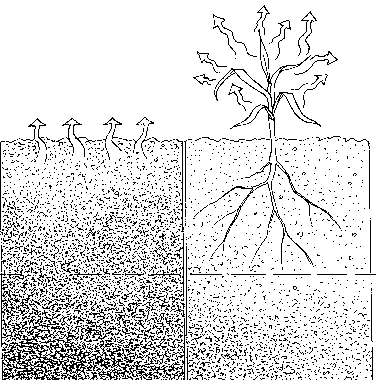chAPter 15 Preventing and lessening CoMPaCtion
Figure 15.7. Reduction of soil compaction by increased distribution of equipment loads. Left: Tracks on a tractor. Middle: Dual wheels on a tractor that also increase traction. Right: Multiple axles and flotation tires on a liquid manure spreader this scenario, emphasis should be placed on improving
wheels similarly reduces compaction by increasing the
the harvesting operations. In another scenario, a high-
footprint, although this load distribution is less effective
plasticity clay loam soil is often spring-plowed when still
for reducing subsoil compaction, because the pressure
too wet. Much of the compaction damage may occur at
cones from neighboring tires (see figure 6.10, p. 64)
that time, and alternative approaches to tillage and tim-
merge at shallow depths. Dual wheels are very effective
ing should be a priority.
at increasing traction but, again, pose a danger because
Better load distribution. Improving the
of the temptation (and ability) to do fieldwork under
design of field equipment may help reduce compac-
relatively wet conditions. Duals are not recommended
tion problems by better distributing vehicle loads. The
on tractors for performing seeding and planting opera-
best example of distributing loads is through the use of
tions because of the larger footprint (see also discussion
tracks (figure 15.7), which greatly reduce the potential
on controlled traffic below).
for subsoil compaction. But beware! Tracked vehicles
Improved soil drainage. Fields that do not drain
may provide a temptation to traffic the land when the
in a timely manner often have more severe compaction
soil is still too wet. Tracked vehicles have better flota-
problems. Wet conditions persist in these fields, and
tion and traction, but they can still cause compaction
traffic or tillage operations often have to be performed
damage, especially through smearing under the tracks.
when the soil is too wet. Improving drainage may go
Plow layer compaction may also be reduced by lowering
a long way toward preventing and reducing compac-
the inflation pressure of tires. A rule of thumb: Cutting
tion problems on poorly drained soils. Subsurface (tile)
tire inflation pressure in half doubles the size of the tire
drainage improves timeliness of field operations, helps
footprint to carry an equivalent equipment load and cuts
dry the subsoil, and, thereby, reduces compaction in
the contact pressure on the soil in half.
deeper layers. On heavy clay soils where the need for
The use of multiple axles reduces the load carried
close drain spacing is very expensive, surface shap-
by the tires. Even though the soil receives more tire
ing and mole drains are effective methods. Drainage is
passes by having a larger number of tires, the result-
discussed in more detail in chapter 17.
ing compaction is significantly reduced. Using large,
Clay soils often pose an additional challenge with
wide tires with low inflation pressures also helps reduce
respect to drainage and compaction, because they
potential soil compaction by distributing the equip-
remain in the plastic state for extended periods after
ment load over a larger soil surface area. Use of dual
drying from wet conditions. Once the upper inch of the
167
Building SoilS for Better CropS: SuStainaBle Soil ManageMent







